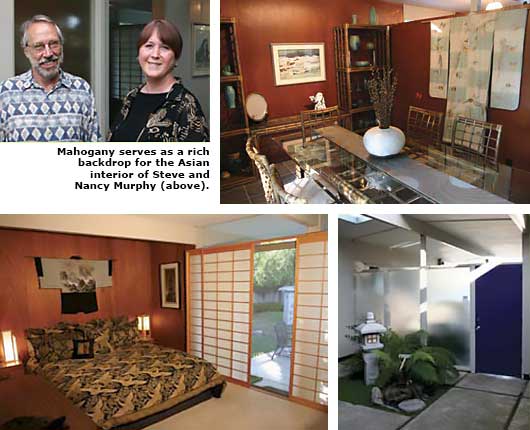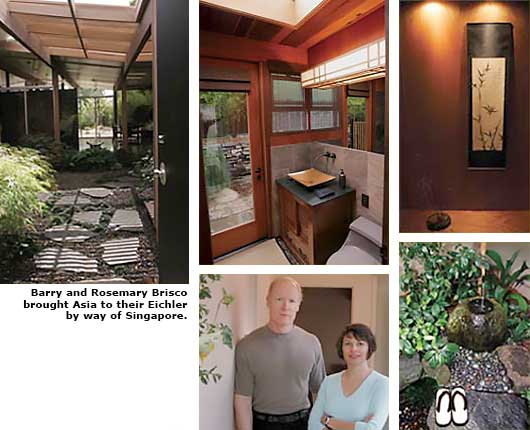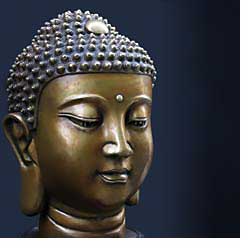East Meets West: Asian Aesthetic - Page 2
In that way, the home is much like the antique haori jacket that hangs above their bed. Made during Japan's Edo period, which ended in 1867, it was designed to be totally blank on the outside but beautifully decorated on the inside. That was due to an edict from the emperor, who didn't want the up-and-coming middle class to display their newfound power and finery in public.
The Murphys, who have collected Japanese antiques for years, have been fans of Eichlers even longer—since they were both children growing up near Eichler's Fairglen neighborhood, where they live today.
Their Japanese furniture, kimonos, fans, shojis, and lanterns work well with their home's original features, including its mahogany paneling. "The house has very simple lines," Steve says. "It goes well with the Japanese aesthetic."
"We tried to blend together the Japanese look and feel without getting way out of hand. We still wanted to retain the Eichler feeling too."

Subtle, minimal house of calm
Barry and Rosemary Brisco, who imbibed Asian style while living four years in Singapore and traveling in the Far East, have blended Asian motifs into their Eichler in a subtle but effective manner.
Facing the street is a freeform ocean of river-washed stones, complete with an island housing a Japanese pine and one perfect boulder. The generous backyard is a sea of pebbles crossed by steppingstone paths. Weeping cherry trees, bamboo, Japanese umbrella pines, and cypress, plus a hillock with a tiny waterfall, add to the effect.
The backyard has a Japanese-style deck instead of the standard Eichler patio, and a standard Japanese 'taking-off-shoe stone.'
The home itself is filled with Buddhas, a family heirloom kimono that is often used as a wall hanging, Japanese screens, a Japanese sea chest, a classic Hans Wegener armchair, an Isamu Noguchi table, and an arrangement of bamboo tubes created by Barry's mother.
A recent interior remodel emphasized the Asian aesthetic, with a bathroom of exposed wooden beams, a tatami, and a tansu-like cabinet for the sink. Cross-laminated bamboo for kitchen cabinets, a room divider, and an entertainment cabinet also adds to the effect.
It sounds like a lot, but the effect is sparse. "Eichler rooms are small by modern standards, so they look good with less furniture," Barry says. The atrium has become a 'tsubo' garden, "a courtyard garden, without grand vistas," Barry explains. It's a place to enjoy as you walk by. "The atrium has flagstone steppingstones over a sea of pebbles, camellias, ornamental grasses. "It's Japanese in the sense that it's minimal," he says, "and there's an attempt to emulate nature without copying it."
Both Barry and Rosemary work from home, but they feel no sense of hustle-bustle. "People remark how calm and peaceful it is," Rosemary says.

Photos: David Toerge
Asian Architecture and Its Principles Make a
Deep Connection at the Roots of California Modern

Kinji Imada was a pure International Style modernist when he visited New York's Museum of Modern Art in 1954 to see a traditional Japanese house that had been constructed in the museum's garden. "That was a real eye-opener for many people," said Imada, at the time a Japanese-American architectural student who had yet to visit Japan.
Imada, who died in 2005, remained a modernist throughout his career, which included helping design Eichler homes as an associate of Claude Oakland. But he retained an interest in Asian architecture.
Mid-century modern architecture, particularly in California, shares many characteristics with Asian architecture. Both are open to the outdoors, have modular structures that are clearly expressed, and a feeling of repose. Few American modernists copied Japanese style directly. But they followed many of the same principles and pursued similar aesthetic ends.
Modern architecture in America harks back primarily to the modern movement in Europe. But Frank Lloyd Wright was influenced by Asia, and Japanese style—more than Chinese, Korean, or other Asian traditions—was much discussed in the 1940s and '50s. Architects understood that the similarities between Asian and modern had less to do with influence than with confluence.




